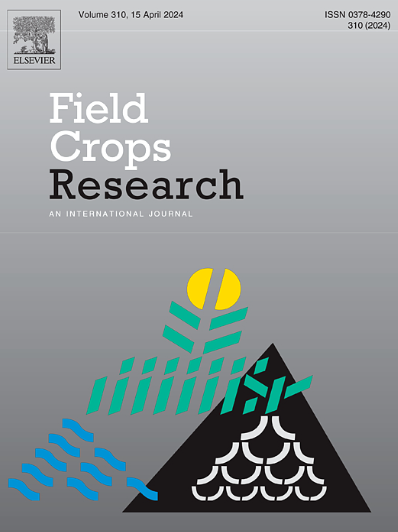Synergies and trade-offs of crop diversification system for productive, energy budget, economic, and environmental indicators in Northeast China
IF 5.6
1区 农林科学
Q1 AGRONOMY
引用次数: 0
Abstract
Context
Continuous maize monoculture in Northeast China maintains higher productivity as well as results in excessive environmental costs. Integrating legume or gramineous crops into maize cropping system is an effective way to achieve high productivity while reducing carbon footprint (CF). However, the performance of different crop diversification systems is not clear so far.
Objectives
The present study aimed to comprehensively evaluate the effects of diversified maize, peanut, and wheat cropping systems on 1) crop productivity, energy budget and economic benefits; 2) environmental costs including CF, net ecosystem economic budget (NEEB), and carbon sustainability index (CSI) in Northeast China.
Methods
A four-year field experiment was conducted in Northeast China, including continuous maize (CM), continuous wheat (CW), continuous peanut (CP), maize and wheat intercropping (M||W), maize and peanut intercropping (M||P), maize and wheat rotation (M→W), maize and peanut rotation (M→P). The life cycle assessment (LCA) and Z-score methods were employed to analyze carbon emission related performance for these treatments.
Results
Crop diversification (i.e., rotation and intercropping system) decreased biomass and grain yield but increased maize equivalent yield (MEY) and protein yield (PY). In particular, the M||P treatment showed 20.9 % and 24.6 % higher MEY and PY, respectively, compared to the CM treatment. Total revenue and net income for the M||P treatment were 20.8 % and 23.7 % higher than the CM treatment. However, M||W, M||P, M→W, and M→P treatments had lower energy yield (EY) and energy use efficiency compared to CM. The CSI was significantly higher for M||W (86.3 %), M||P (81.6 %), and M→W (46.4 %) treatments compared to CM. The M||P showed the lowest CF per unit equivalent yield (CFMEY), per unit energy yield (CFEY), and per unit economic benefit (CFE), which were 58.6 %, 47.3 %, and 59.5 % lower than CM, respectively. Additionally, the M||P treatment had the highest NEEB of 15307.6 CNY ha−1, which was 24.4 % higher than CM. Overall, M||P treatments demonstrated more positive effects with the highest comprehensive score of 20.1 due to higher yield, economic return, and lower environmental cost among the treatments.
Conclusions
It is indicated that crop diversification practices, particularly the M||P system, can achieve higher profitability and NEEB while maintaining a lower CF in Northeast China.
Implications
This study underpins that maize and peanut intercropping is a viable alternative to traditional maize monoculture in Northeast China, which offers improved economic returns and environmental sustainability. However, the potential negative impact on energy yield should be considered when implementing such systems.
东北作物多样化系统对生产、能源预算、经济和环境指标的协同效应与权衡
东北地区玉米单作连作在保持较高产量的同时,也造成了过高的环境成本。将豆科或禾本科作物整合到玉米种植系统中是实现高产和减少碳足迹(CF)的有效途径。然而,迄今为止,不同作物多样化系统的效果尚不清楚。目的综合评价玉米、花生和小麦不同种植制度对作物生产力、能量收支和经济效益的影响;2)环境成本包括CF、净生态系统经济预算(NEEB)和碳可持续性指数(CSI)。方法采用玉米连作(CM)、小麦连作(CW)、花生连作(CP)、玉米与小麦间作(M||W)、玉米与花生间作(M||P)、玉米与小麦轮作(M→W)、玉米与花生轮作(M→P)等4年大田试验。采用生命周期评价(LCA)和Z-score方法分析各处理的碳排放相关绩效。结果作物多样化(即轮作和间作)降低了生物量和粮食产量,但提高了玉米当量产量和蛋白质产量。其中,与CM处理相比,M||P处理的年均经济效益和年均经济效益分别提高20.9 %和24.6 %。P处理的总收益和净收入比CM处理分别高出20.8% %和23.7% %。而M||W、M b| |P、M→W和M→P处理的能量产量和能量利用效率均低于CM处理。M||W(86.3 %)、M||P(81.6 %)和M→W(46.4 %)处理的CSI显著高于CM。M||P的单位当量产量(CFMEY)、单位能量产量(CFEY)和单位经济效益(CFE)最低,分别比CM低58.6 %、47.3 %和59.5 %。此外,M||P处理的NEEB最高,为15307.6 CNY ha - 1,比CM高24.4 %。综上所示,M + | + | + P处理产量高、经济效益好、环境成本低,综合得分最高,达20.1分。结论作物多样化措施,特别是M b| b| P系统,在保持较低CF的同时,可以获得较高的盈利能力和NEEB。结果表明,在东北地区,玉米花生间作是替代传统玉米单作的可行选择,具有较高的经济效益和环境可持续性。然而,在实施此类系统时,应考虑对能源产量的潜在负面影响。
本文章由计算机程序翻译,如有差异,请以英文原文为准。
求助全文
约1分钟内获得全文
求助全文
来源期刊

Field Crops Research
农林科学-农艺学
CiteScore
9.60
自引率
12.10%
发文量
307
审稿时长
46 days
期刊介绍:
Field Crops Research is an international journal publishing scientific articles on:
√ experimental and modelling research at field, farm and landscape levels
on temperate and tropical crops and cropping systems,
with a focus on crop ecology and physiology, agronomy, and plant genetics and breeding.
 求助内容:
求助内容: 应助结果提醒方式:
应助结果提醒方式:


